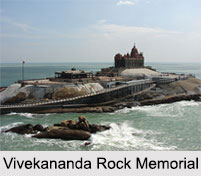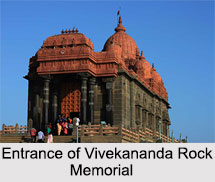 The Vivekananda Rock Memorial was constructed in honour of the great religious leader and Hindu monk of India, Swami Vivekananda. This rock is also considered holy as local myths say Goddess Devi Kumari blessed the rock while performing asceticism. People from different corners of the country come here just to have a glimpse of this place.
The Vivekananda Rock Memorial was constructed in honour of the great religious leader and Hindu monk of India, Swami Vivekananda. This rock is also considered holy as local myths say Goddess Devi Kumari blessed the rock while performing asceticism. People from different corners of the country come here just to have a glimpse of this place.
The Vivekananda Rock Memorial today rises as an architectural wonder depicting a variety of architecture styles of India and attracts thousands of visitors round the year. The term means that the rock has been blessed by the touch of Shripada feet of the Goddess. According to legend, Goddess Kanyakumari performed Tapas on this rock. Vivekananda Rock is also called "Sripada Parai" as it is believed that Goddess Devi Kumari blessed the place with the touch of her holy feet.
Location of Vivekananda Rock Memorial
Vivekananda Rock Memorial stands on one of two rocks situated about 500 meters east off mainland of Vavathurai, Kanyakumari, India`s mainland`s southernmost tip.
History of Vivekananda Rock Memorial
As its name implies, it is basically a sacred monument, built by the Vivekananda Rock Memorial Committee to commemorate the visit of Swamy Vivekananda to "Shripada Parai" during 24th, 25th and 26th December 1892 for deep meditation and enlightenment. In Puranic tradition, it has been known as "Sripada Parai".
In January 1962, on the event of Swami Vivekananda"s birth anniversary, a group of people formed the Kanyakumari Committee whose purpose was to put up a monument on the rock and a walker bridge leading to the rock. This led to objections by the Hindu population who said the rock was a place of worship for Hindus. With government consent, the tablet was installed on the rock on 17th January 1963. It was inaugurated on September 2, 1970 by the President of India Shri V.V. Giri.
Architecture of Vivekananda Rock Memorial
Vivekananda Rock Memorial consists of Dhyana Mandapam which is the meditation Hall with six adjoining rooms. There is a Sabha Mandapam which is the Assembly Hall with Pralima Mandapam two rooms. It has a corridor and an open prakaram round the Sabha Mandapam.
Shripada Mandapam is a square hall consisting of Garbha Graham, Inner Prakaram, Outer Prakaram and Outer Platform. Both the Mandapams are so constructed that the visualization of Vivekananda in the statue would be seen straight towards the Shripadam. This rock has great implication religiously as well. There is also Sri Padaparai Mandapam which is a holy place stiffed at the spot where the footstep of the Goddess Sripada Parai was seen on the rock. Vivekananda Rock Memorial has a mix of Tamil Nadu and West Bengal style of architecture.
Visiting information of Vivekananda Rock Memorial
Instead of Kanyakumari people can a take flight to Thiruvananthapuram International Airport on regular root. There are regular trains from other main cities of the country to Kanyakumari. Kanyakumari is well connected to other major cities of the country through regular buses. There are a lot of transport services that run between the island and the mainland with minimum charges.






